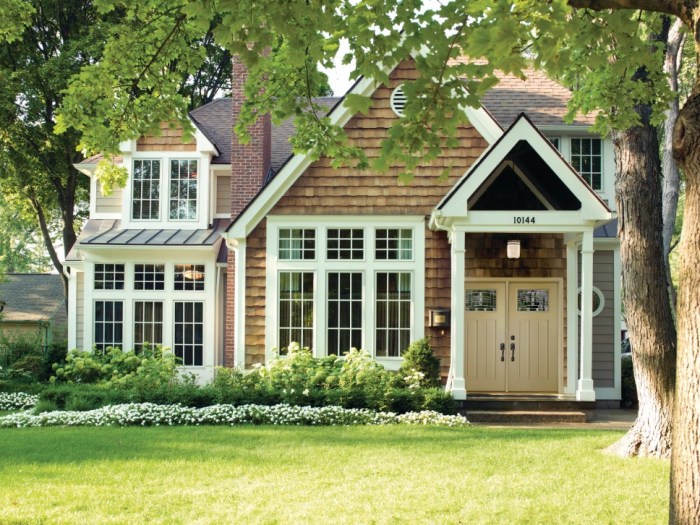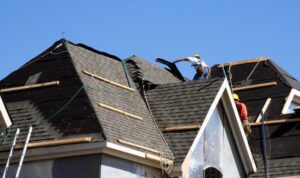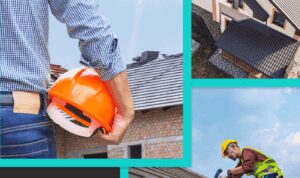Exploring the realm of energy efficient home exteriors, this article delves into the key aspects that make a home environmentally friendly and cost-effective. From insulation to sustainable materials, we cover it all in a casual formal language style that aims to inform and inspire.
Energy-Efficient Home Exteriors Overview

Energy-efficient home exteriors refer to the use of materials and design techniques that help reduce energy consumption and improve overall sustainability in residential buildings. These exteriors are designed to minimize heat transfer, air leakage, and energy waste, ultimately leading to lower utility bills and a reduced environmental footprint.
The importance of energy efficiency in home exteriors cannot be overstated. By investing in energy-efficient materials and construction practices, homeowners can significantly decrease their energy usage, lower their carbon footprint, and create a more comfortable living environment. Additionally, energy-efficient exteriors can increase the overall value of a home and contribute to a healthier indoor environment for occupants.
Benefits of Energy-Efficient Exteriors
- Reduced Energy Costs: Energy-efficient home exteriors help lower heating and cooling expenses by minimizing energy waste and improving insulation.
- Environmental Impact: By reducing energy consumption, homeowners with energy-efficient exteriors contribute to a smaller carbon footprint and help combat climate change.
- Improved Comfort: Proper insulation and air sealing in energy-efficient exteriors create a more consistent indoor temperature and reduce drafts, leading to enhanced comfort levels for occupants.
- Increased Home Value: Energy-efficient features are attractive to potential buyers and can increase the resale value of a home.
- Long-Term Savings: While the initial investment in energy-efficient exteriors may be higher, the long-term savings on energy bills make it a cost-effective choice in the long run.
Insulation and Weatherization
Insulation and weatherization play crucial roles in creating energy-efficient home exteriors. Proper insulation helps to maintain a consistent indoor temperature, reducing the need for excessive heating or cooling. Weatherization techniques help seal any gaps or leaks in the structure, preventing air leakage and improving overall energy efficiency.
Types of Insulation Materials
- Fiberglass: Made of fine glass fibers, it is a common and cost-effective insulation material suitable for exteriors.
- Spray Foam: Expands to fill gaps and creates a tight seal, providing excellent insulation properties.
- Cellulose: Made from recycled paper or plant fibers, it is eco-friendly and offers good thermal performance.
Weatherization Techniques
- Sealing Air Leaks: Caulking and weatherstripping windows and doors to prevent drafts and heat loss.
- Insulating Attic and Walls: Adding insulation to these areas to improve energy efficiency and reduce heating and cooling costs.
- Installing Energy-Efficient Windows: Double or triple-pane windows with low-e coatings to minimize heat transfer.
- Proper Ventilation: Ensuring adequate ventilation to prevent moisture buildup and maintain indoor air quality.
Energy-Efficient Windows and Doors
Energy-efficient windows and doors play a crucial role in improving the overall energy efficiency of a home. They help in reducing heat loss during winters and heat gain during summers, resulting in lower energy bills and increased comfort.
Characteristics of Energy-Efficient Windows and Doors
- High-quality insulation materials such as low-emissivity (Low-E) glass or double/triple-pane windows with gas fillings to reduce heat transfer.
- Multiple layers of weather stripping to prevent air leakage and drafts.
- Proper framing materials like vinyl, fiberglass, or wood-clad for enhanced insulation properties.
- Efficient design features such as thermal breaks and spacers to minimize heat transfer through the frame.
- Energy Star certification to ensure the products meet strict energy efficiency standards.
Comparison of Energy-Efficient Window and Door Materials
When choosing energy-efficient windows and doors, it's essential to consider the material used as it directly impacts their performance and durability.
| Material | Pros | Cons |
|---|---|---|
| Vinyl | Low maintenance, good insulation, cost-effective. | May warp in extreme temperatures. |
| Fiberglass | Durable, energy-efficient, customizable. | More expensive upfront cost. |
| Wood-Clad | Natural look, excellent insulation. | Requires regular maintenance. |
Importance of Proper Installation for Maximizing Energy Efficiency
- Correct installation ensures a tight seal, preventing air leaks and maintaining insulation efficiency.
- Poor installation can lead to energy loss, condensation issues, and reduced lifespan of the windows and doors.
- Professional installation by experienced contractors is recommended to guarantee optimal performance and energy savings.
Sustainable Exterior Materials
When it comes to energy-efficient home exteriors, using sustainable materials is not only beneficial for the environment but also for reducing energy consumption and costs. Sustainable materials are typically sourced responsibly, have a lower carbon footprint, and are durable, making them ideal for creating energy-efficient homes.
Sustainable Materials for Energy-Efficient Exteriors
- Bamboo: A renewable resource that grows quickly and is strong enough to be used for various exterior applications such as decking and siding.
- Recycled Steel: Using recycled steel for roofing and siding can help reduce the demand for new materials and lower the energy required for production.
- Cork: Cork is a sustainable material that can be used for exterior insulation, providing both thermal and sound insulation properties.
Environmental Benefits of Sustainable Materials
- Reduced Carbon Footprint: Sustainable materials often require less energy to produce, reducing greenhouse gas emissions.
- Promote Biodiversity: Sourcing materials responsibly can help protect natural habitats and preserve biodiversity.
- Longevity: Sustainable materials are typically more durable, reducing the need for frequent replacements and further lowering environmental impact.
Examples of Sustainable Exterior Materials and Energy-Saving Properties
| Material | Energy-Saving Properties |
|---|---|
| Bamboo | Highly renewable, strong, and provides natural insulation. |
| Recycled Steel | Reduces demand for new materials, lowers energy consumption during production, and offers durability. |
| Cork | Provides thermal and sound insulation, sourced sustainably from cork oak trees. |
Landscaping for Energy Efficiency
Landscaping plays a crucial role in enhancing the energy efficiency of a home by providing shade, reducing heat gain, and improving insulation. By strategically designing your outdoor space, you can effectively lower your energy consumption and create a more sustainable living environment.
Designing a Landscape for Energy Efficiency
- Planting deciduous trees on the south and west sides of your home can provide shade during the hot summer months, reducing the need for air conditioning.
- Using dense shrubs and bushes near walls and windows can act as a windbreak, reducing heat loss during the winter and improving overall insulation.
- Installing trellises with climbing plants can create natural shading on walls, reducing heat absorption and lowering indoor temperatures.
The Role of Trees, Shrubs, and Other Elements
- Trees not only provide shade but also help cool the surrounding air through evapotranspiration, further reducing the need for mechanical cooling.
- Shrubs and bushes can create a buffer zone around your home, protecting it from harsh winds and extreme temperatures, thus reducing energy consumption.
- Grass and permeable surfaces can help reduce heat absorption and minimize the urban heat island effect, contributing to a cooler outdoor environment.
Exterior Lighting and Energy Conservation
When it comes to energy-efficient home exteriors, the importance of exterior lighting cannot be overlooked. Energy-efficient outdoor lighting not only helps reduce energy consumption but also enhances the overall aesthetics and safety of your home.
Types of Energy-Efficient Outdoor Lighting
- LED Lighting: LED lights are highly energy-efficient and have a longer lifespan compared to traditional incandescent bulbs.
- Solar-Powered Lights: These lights harness solar energy during the day and use it to illuminate your outdoor space at night, reducing electricity consumption.
- Motion Sensor Lights: Motion sensor lights only turn on when they detect movement, helping to conserve energy when the light is not needed.
Designing a Lighting Plan for Energy Conservation
Creating a lighting plan that conserves energy involves strategic placement of lights, using timers or sensors, and choosing the right fixtures. Here are some tips:
- Use timers or motion sensors to control when the lights are on, ensuring they are only used when necessary.
- Opt for energy-efficient LED bulbs that consume less energy and have a longer lifespan.
- Consider the placement of lights to avoid over-illumination and light pollution.
- Choose fixtures that direct light where it is needed most, such as pathway lighting or accent lights.
Concluding Remarks
In conclusion, energy efficient home exteriors are not just a trend but a sustainable way to reduce energy costs and minimize environmental impact. By implementing the strategies discussed, homeowners can create a greener and more efficient living space for years to come.
Commonly Asked Questions
What are the key benefits of energy-efficient home exteriors?
Energy-efficient home exteriors can lead to lower energy bills, reduced environmental impact, and increased comfort levels inside the home.
How do landscaping choices affect the energy efficiency of a home?
Strategic landscaping can provide shade, reduce heat absorption, and create natural insulation, all contributing to energy savings.









